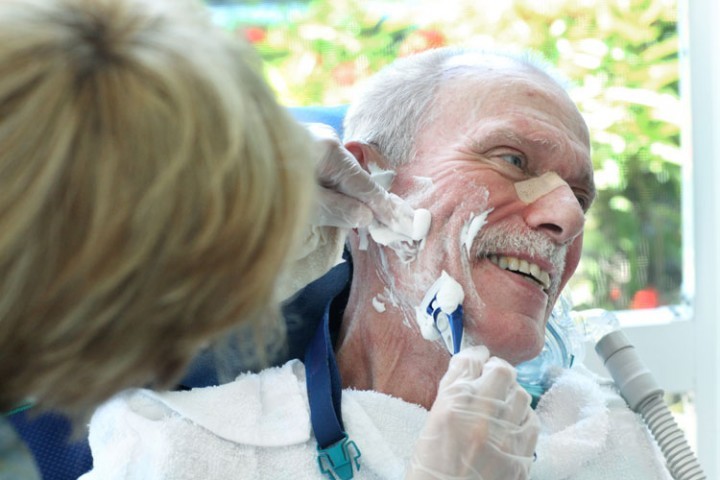
INDIAN RIVER COUNTY — Four Roseate Spoonbills wade through water pooled at the side of the long driveway that leads from 37th Street to the Visiting Nurses Association Hospice House, adding a much-needed touch of color on a damp, gray afternoon.
Hospice House sits at the end of the driveway, a low-slung, rambling building with grey clapboards and white trim on 4.2 acres, surrounded by thick vegetation and small ponds.
The facility appears like it would be more at home on Sanibel or Captiva island welcoming high-paying guests for fun-filled weekend getaways, not sitting squat in the middle of Indian River County’s medical hub along 37th Street.
Hospice provides 12 rooms for patients with terminal or chronic diseases who are nearing the end of their lives. Over the course of this year, it will serve about 1,000 patients, both in the hospice or in their homes.
The setting is about as far from institutional-like health care as one can imagine. No glossy, easy-to-clean floors.
No machinery humming or beeping away.
In fact, during a recent tour, Karen Ritchie, the VNA’s vice president of professional services for hospice, points to a dark wood cabinet near a patient’s bed.
She points out that’s where the oxygen some patients need comes into the room. Visually, it’s much more pleasing, she notes, than the sight of oxygen tanks.
Patient rooms are more like rooms at an upscale hotel or high-end B&B.
They feature carpeting, private baths, flat screen televisions, warm colors in various brown or gold hues, crown molding and screened porches that overlook at a pond at the back of the property.
“In their rooms, patients can bring whatever makes them comfortable,” says Ritchie. “They can have pets. They can have grandchildren stay with them.
“It’s about quality of life until the end of life,” Ritchie says of the hospice program. “If a patient wants to turn the bed to watch the sunrise, they can turn the bed to watch the sunrise. If they want to put a bed on the porch, they can put a bed on the porch.”
Hospice also has a kitchen with its own chef and residents are provided menus. Ritchie says if patients want something special they can bring it in.
Ritchie says that on a typical day at hospice, seven of the 12 beds are filled although weekends are busiest.
“Sometimes, we are filled to the brim and have a waiting list,” she adds.
Cancer used to be the predominant disease among hospice patients, says Ritchie, affecting 57 percent of patients.
Now, the cancer prevalence among patients is about 43 percent.
Patients with Alzheimer’s disease, Parkinsons’ disease, chronic obstructive pulmonary disease (COPD) Lou Gehrig’s disease and other chronic ailments have replaced the cancer victims.
Although Medicare pays for patients who are expected to live six months or less, Ritchie says some patients have been with hospice for two years.
Contrary to what many people might think, hospice is not full of people with just a few days to live.
Some spend just five days at hospice in a program that provides a break for patients’ regular caregivers.
Then, they go home.
Medicare foots the bill – for five days a month – so caregivers get that needed break, says Ritchie. “Think of it as a five-day hotel stay.”
Other patients go to hospice, get their pain under control and go home.
“Hospice often impacts the progression of the disease so patients are living longer,” says Michael Gardner, the VNA’s vice president of marketing and communications.
That’s because patient’s lives improve under hospice care, he says, because earlier pain management and the support of their families have big impacts on their lives.
About 30 percent of the people who use hospice go home, including a growing number of people who opt out of the program.
“Anyone can get out,” says Ritchie. “Anyone can revoke their (Medicare) benefit. That happens pretty frequently.”
Ritchie says that’s a generational change.
“People in their 80s and 90s were WWII veterans and believe the doctor’s opinion was absolute,” she says.
That’s no longer the case. The newer generation, Baby Boomers, says Ritchie, doesn’t take what the doctor says as gospel, meaning they are more likely to opt out of the hospice program in the hope a new treatment will work.
Admission to hospice is determined by a cadre of social workers, nurses, chaplains, the patient, family, physicians, neighbors or a hospitalist, and the six-month Medicare rule is applied, says Ritchie.
“The family needs to be on board,” says Ritchie. “They have to understand that the concept is longer than a couple of weeks.”
Although they might not be eligible when first diagnosed, Ritchie says, people should contact hospice at that point.
Although to many, the subject of death on a weekly or even a daily basis might be stressful, Ritchie says staff is carefully screened and they emphasize that employees need a life outside their jobs.
Ritchie says when potential employees are screened, the VNA focuses on whether the potential worker will be able to “tie up” their day and go home. “We ask them, what are the healthy things you do?
“We expect them to give 110 percent to the patients and 110 percent to their own lives,” she adds.
Still, if a death is particularly traumatic for staff, they will talk about it together.
“We have the ability to talk with counselors when a death has been particularly difficult,” Ritchie says.
Ritchie also says staff turnover is very low.
“I’ve had people refer to it as a calling rather than a career,” says Gardner. Ritchie puts it in more simple terms.
“It’s a privilege to be part of the journey,” she says. “There are a lot of stories that amaze and inspire.”



